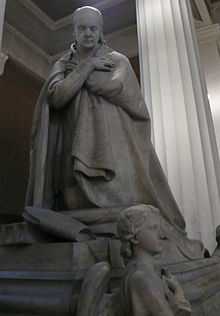Daniel Murray (bishop)
| The Most Reverend Daniel Murray | |
|---|---|
|
Archbishop of Dublin Primate of Ireland | |
 Daniel Murray at the Pro-Cathedral Dublin | |
| Church | Roman Catholic |
| See | Dublin |
| In office | 1823 - 1852 |
| Predecessor | John Troy |
| Successor | Paul Cullen |
| Personal details | |
| Born |
18 April 1768 Arklow, Ireland |
| Died | 26 February 1852 |
Daniel Murray (1768, at Sheepwalk, near Arklow, Ireland - at Dublin, 1852) was a Roman Catholic Archbishop of Dublin.
Life
He was born on 18 April 1768 at Sheepwalk, near Arklow, co. Wicklow, the son of a farmer. [1] He was educated at Dr. Betagh's school, and at Salamanca, and ordained priest in 1790. After some years as curate in Dublin he was transferred to Arklow, and was there in 1798 when the rebellion broke out. The soldiers shot the parish priest in bed and Murray, to escape a similar fate, fled to the city where for several years after he ministered as curate.
In 1809, at the request of Archbishop Troy he was appointed coadjutor bishop, and in 1823, on Dr. Troy's death, he became Archbishop of Dublin. While coadjutor he had filled for one year the position of president of Maynooth College.
On the death of Archbishop Troy, in 1823 Murray succeeded to the see of Dublin. He enjoyed the confidence of successive popes, and was held in high respect by the British government. Pusey had an interview with him in 1841, and bore testimony to his moderation, and Newman had some correspondence with him before 1845. A seat in the privy council at Dublin, officially offered to him in 1846, was not accepted.[1]
His life was mainly devoted to ecclesiastical affairs, the establishment and organisation of religious associations for the education and relief of the poor. Among these was the order of the 'Sisters of Charity,' for the constitution of which he obtained papal confirmation. As a preacher, Murray is stated to have been 'pre-eminently captivating and effective,' especially in appeals for charitable objects. Murray took part in the synod of the Roman Catholic clergy at Thurles in 1850, and died at Dublin on 26 February 1852. [1]
He was interred in the pro-cathedral, Dublin, where a marble statue of him has been erected in connection with a monument to his memory, executed by James Farrell, president of the Royal Hibernian Academy of Fine Arts. [1]
Positions
Murray was an uncompromising opponent of the "veto" and a strong supporter of the Catholic Association. On other questions he was less extreme, and was in such favour at Dublin Castle that he was once offered a seat on the Privy Council, which he declined. He supported Stanley's National Education scheme and among the first Education Commissioners, he wished to tolerate the Queen's Colleges, in opposite to the views of Archbishop John MacHale. He had hesitation, however, in accepting the adverse decision of Rome, and was present at the Synod of Thurles where the Queen's Colleges were formally condemned.
References
- ↑ 1.0 1.1 1.2 1.3 Gilbert 1894.
- Attribution
![]() This article incorporates text from a publication now in the public domain: Gilbert, John Thomas (1894). "Murray, Daniel". In Lee, Sidney. Dictionary of National Biography 39. London: Smith, Elder & Co.
This article incorporates text from a publication now in the public domain: Gilbert, John Thomas (1894). "Murray, Daniel". In Lee, Sidney. Dictionary of National Biography 39. London: Smith, Elder & Co.
Sources
- D'Alton, Archbishops of Dublin (Dublin, 1838)
- Healy, Centenary History of Maynooth College (Dublin, 1895)
- Meagher, Life of Archbishop Murray (Dublin, 1853)
- FitzPatrick, Life of Dr. Doyle (Dublin, 1880)
- O'Reilly, Life of Archbishop MacHale (New York, 1890)
External links
- D'Alton, Edward (1911). "Daniel Murray". Catholic Encyclopedia 10. New York: Robert Appleton Company.
|